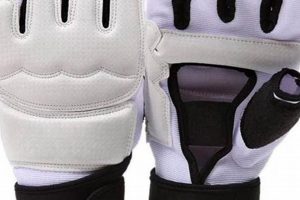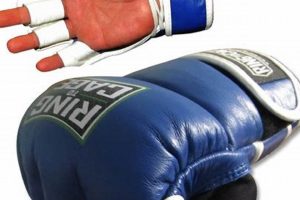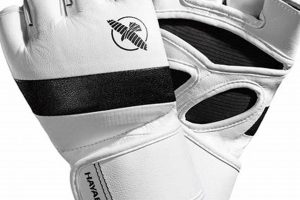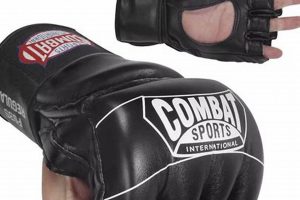The mass of hand protection worn by mixed martial arts competitors is a critical factor in the sport. Different fighting organizations and weight classes may have specific requirements for this protective gear, often measured in ounces. For instance, professional fighters frequently use four-ounce gloves, while amateurs or those in training might opt for heavier options offering greater hand protection.
The prescribed mass of these gloves influences the force of impacts, affecting both fighter safety and the dynamics of combat. Lighter gloves can generate more powerful strikes, potentially leading to quicker knockouts, but also increasing the risk of hand injuries. Heavier gloves offer greater padding, absorbing more impact and reducing the likelihood of broken bones, but may decrease striking power. Historically, the standardized mass has evolved, aiming to balance safety with the excitement of the sport.
This exploration will delve deeper into various aspects of protective handwear in mixed martial arts, including the different categories based on mass, their influence on fighting styles, and the ongoing debate surrounding safety, performance, and regulations.
Tips for Selecting Appropriate Hand Protection in Mixed Martial Arts
Choosing suitable hand protection is crucial for both performance and safety in mixed martial arts. The following tips provide guidance for selecting the appropriate mass for training and competition.
Tip 1: Adhere to Regulatory Standards: Always verify the required mass for specific competitions and organizations. Using non-compliant gear can lead to disqualification.
Tip 2: Consider Experience Level: Less experienced individuals may benefit from heavier options for increased hand protection during training. As technique improves, a transition to lighter options can be considered.
Tip 3: Prioritize Hand Safety: If hand injuries are a concern, prioritize heavier gloves that offer greater padding and shock absorption, even during training.
Tip 4: Balance Protection and Power: Lighter gloves offer greater striking power but less protection. Heavier gloves offer more protection but reduce striking force. Finding the right balance is essential.
Tip 5: Factor in Fighting Style: A fighter relying on grappling techniques may prefer a lighter glove for improved grip, while a striker might opt for heavier options for hand protection during powerful blows.
Tip 6: Consult with a Coach: Experienced coaches can provide personalized recommendations based on individual needs, skill level, and fighting style.
Tip 7: Test Different Options: Whenever possible, try out various masses during training to determine the optimal balance between comfort, protection, and performance.
By carefully considering these factors, athletes can select hand protection that optimizes safety and performance, allowing for effective training and competition.
Understanding the nuances of hand protection in mixed martial arts is essential for maximizing both safety and performance. This information provides a foundation for informed decision-making and encourages further exploration of this critical aspect of the sport.
1. Protection
Glove weight plays a critical role in hand and wrist protection in mixed martial arts. The degree of protection offered directly correlates with glove weight, influencing a fighter’s vulnerability to injury. Understanding this relationship is essential for informed decision-making regarding glove selection for both training and competition.
- Hand Protection
Heavier gloves provide more padding, reducing the force transmitted to the hands during impact. This added protection decreases the risk of fractures and sprains, particularly in the metacarpals and phalanges. For example, heavier training gloves often used by beginners significantly reduce hand injury risk compared to the lighter gloves used in professional bouts. The trade-off, however, is potentially reduced striking power.
- Wrist Support
While all MMA gloves offer some wrist support, heavier gloves often incorporate additional padding and strapping mechanisms to stabilize the wrist joint. This added support helps prevent hyperextension and other wrist injuries common in combat sports. Professional fighters, despite using lighter gloves in competition, frequently utilize heavier gloves with enhanced wrist support during training to minimize injury risk.
- Opponent Protection
Glove weight also influences the potential for injury to opponents. While seemingly counterintuitive, heavier gloves can sometimes reduce the risk of superficial facial injuries. The increased surface area and padding distribute the impact force over a wider area, potentially lessening the severity of cuts and bruises. This factor is particularly relevant in amateur competitions and training scenarios.
- Long-Term Health Considerations
Repeated impacts, even with protective gear, can contribute to cumulative hand and wrist trauma. Selecting gloves with appropriate weight and padding is crucial for mitigating long-term damage. Fighters are advised to consult with medical professionals and coaches to determine the optimal balance between protection and performance for their individual needs.
The level of protection provided by MMA gloves is intrinsically linked to their weight. While heavier gloves enhance protection, they can compromise striking power. This inherent trade-off necessitates careful consideration of individual needs, training objectives, and competition regulations when selecting appropriate hand protection.
2. Power
The relationship between glove weight and striking power in mixed martial arts is significant. Lighter gloves, typically four ounces in professional bouts, facilitate faster hand speed and, consequently, greater striking power. This is due to reduced resistance during acceleration and deceleration. A fighter wearing lighter gloves can generate more kinetic energy upon impact, increasing the likelihood of knockouts. Conversely, heavier gloves, common in training, diminish striking power due to the increased mass. While this reduction in force safeguards against injury during sparring, it also necessitates adjustments in training regimens to account for the difference in impact compared to competition scenarios. Consider a welterweight fighter transitioning from training with heavier sixteen-ounce gloves to competition-standard four-ounce gloves. The substantial difference in weight significantly impacts their punching power and perceived speed. This necessitates specific training drills focused on adapting to the lighter gloves and maximizing the potential for generating knockout blows.
The impact of glove weight on power extends beyond simple physics. It influences tactical decisions within a fight. Fighters wearing lighter gloves might prioritize striking and headhunting, capitalizing on their increased knockout potential. Conversely, those with heavier gloves, often seen in amateur or training settings, may favor grappling and ground-and-pound techniques, where the reduced striking power is less of a disadvantage. For instance, a fighter accustomed to heavier gloves might struggle to effectively implement a striking-heavy strategy in a competition using lighter gloves. They would need to adjust their tactics, potentially focusing on body shots or grappling exchanges to mitigate the relative disadvantage in striking power.
Understanding the interplay between glove weight and power is crucial for both fighters and coaches. Strategic glove selection, tailored to the fighters style and the specific context of competition or training, can significantly impact performance. This understanding also highlights the importance of targeted training regimens designed to optimize power output based on the anticipated glove weight. Ignoring this relationship can lead to mismatched expectations and suboptimal performance in the ring or cage. Fighters must adapt their strategies and techniques to effectively utilize the advantages and mitigate the disadvantages presented by different glove weights.
3. Safety
Glove weight significantly influences fighter safety in mixed martial arts, impacting both the risk of acute injuries and the potential for long-term health consequences. Careful consideration of glove weight is essential for promoting a safe training and competitive environment. This examination explores the multifaceted relationship between glove weight and safety, analyzing its impact on various aspects of fighter well-being.
- Hand and Wrist Injuries
Heavier gloves offer increased padding, reducing the force transmitted to the hands during strikes. This added protection mitigates the risk of fractures, sprains, and contusions to the delicate bones of the hand and wrist. While lighter gloves maximize striking power, they offer less protection, increasing the likelihood of hand injuries, particularly in the metacarpals. This trade-off between power and safety is a central consideration in glove selection.
- Head Trauma
The relationship between glove weight and head trauma is complex. While lighter gloves generate more powerful blows, potentially leading to concussions, heavier gloves can also contribute to a different type of head trauma. The increased mass can deliver more significant blunt force trauma, particularly in scenarios involving ground-and-pound. This highlights the importance of appropriate glove selection for different training and competition contexts.
- Facial Lacerations
Lighter gloves, with their reduced surface area, concentrate impact force, increasing the likelihood of cuts and lacerations. Heavier gloves distribute the force over a wider area, potentially reducing the severity of facial injuries. However, the added mass of heavier gloves can still cause significant blunt force trauma, leading to contusions and swelling. This nuance underscores the need for a balanced approach to glove weight selection.
- Long-Term Health Implications
Repeated impacts, even with protective gear, contribute to cumulative trauma. The choice of glove weight influences the long-term health of fighters. While lighter gloves may increase the risk of acute injuries, heavier gloves can contribute to chronic joint problems and repetitive stress injuries. A comprehensive approach to fighter safety necessitates considering both immediate and long-term health implications of glove weight.
Glove weight is integral to fighter safety, affecting various injury risks and long-term health outcomes. A balanced approach, considering both the protective benefits of heavier gloves and the performance advantages of lighter gloves, is essential for creating a safe and sustainable training and competition environment in mixed martial arts. Further research continues to explore the optimal balance between these factors, striving to enhance fighter safety without compromising the integrity of the sport.
4. Regulations
Regulations governing glove weight in mixed martial arts are crucial for ensuring fair competition and, most importantly, fighter safety. These regulations, often varying between professional and amateur organizations, stipulate permissible glove weights for different weight classes. A primary objective of these regulations is to mitigate the risk of serious injury while maintaining the dynamic nature of the sport. For instance, the Unified Rules of Mixed Martial Arts, adopted by many state athletic commissions, mandate four-ounce gloves for professional bouts. This standardization ensures a level playing field and allows for consistent evaluation of fighter performance. Conversely, amateur organizations frequently require heavier gloves, often six or eight ounces, to provide additional hand protection for less experienced competitors. This distinction reflects a prioritization of safety over striking power in the development of amateur fighters.
The rationale behind these regulations stems from the direct correlation between glove weight and injury risk. Lighter gloves, while enhancing striking power, increase the potential for hand and wrist injuries, as well as the risk of cuts and concussions for opponents. Heavier gloves, by contrast, offer greater protection but can diminish striking force and potentially alter fighting strategies. The regulatory bodies must carefully balance these factors, striving to minimize injury risk without unduly compromising the excitement and dynamism of the sport. A case in point is the ongoing debate regarding the use of four-ounce gloves in professional MMA. While some argue that they contribute to more exciting fights with higher knockout rates, others express concern about the increased risk of hand injuries and concussions. This debate underscores the challenges faced by regulatory bodies in balancing competing interests and the need for ongoing review and adaptation of regulations in light of evolving medical understanding and sporting dynamics.
Understanding the regulatory landscape surrounding glove weight is essential for all stakeholders in mixed martial arts, from fighters and coaches to promoters and officials. Compliance with these regulations is not merely a matter of adherence to rules but a fundamental component of ensuring fighter safety and the long-term health of the sport. The continued evolution of these regulations, informed by scientific research and practical experience, remains a vital aspect of the ongoing development and sustainability of mixed martial arts. Further investigation into the long-term effects of different glove weights, coupled with ongoing dialogue between regulatory bodies, medical professionals, and the fighting community, will be crucial for refining these regulations and ensuring the continued safety and fairness of the sport.
5. Impact Force
Impact force, the force generated upon striking, is inextricably linked to glove weight in mixed martial arts. Understanding this relationship is crucial for comprehending the dynamics of the sport, influencing both offensive and defensive strategies, and informing safety considerations. This exploration delves into the multifaceted connection between impact force and glove weight, analyzing its implications for fighter performance and well-being.
- Kinetic Energy and Momentum
The physics of impact involve kinetic energy and momentum. Lighter gloves, due to reduced mass, allow for faster hand speed, resulting in greater kinetic energy upon impact. This increased energy translates to a higher force delivered to the opponent. Conversely, heavier gloves reduce hand speed and thus kinetic energy, lessening the impact force. This principle explains why lighter gloves are favored for knockouts, while heavier gloves are preferred for training, mitigating injury risk.
- Force Distribution and Injury Risk
Glove weight influences the distribution of force upon impact. Lighter gloves concentrate the force over a smaller area, increasing the likelihood of localized trauma, such as cuts and fractures. Heavier gloves distribute the force over a larger area, potentially reducing the severity of localized injuries but increasing the risk of blunt force trauma. This distinction highlights the importance of selecting appropriate glove weight for different contexts, balancing power with safety.
- Impact Absorption and Padding
The padding within a glove plays a crucial role in impact absorption. Heavier gloves typically contain more padding, dissipating a greater proportion of the impact force. This reduces the force transmitted to both the striker and the recipient of the blow. However, excessive padding can also hinder dexterity and grappling effectiveness. The optimal balance between padding and dexterity is a key consideration in glove design and selection.
- Biomechanical Factors
The biomechanics of a punch, including technique, speed, and body weight, interact with glove weight to determine the final impact force. A technically sound punch delivered with proper body mechanics amplifies the effect of glove weight, maximizing impact force with lighter gloves and minimizing injury risk with heavier gloves. This underscores the importance of proper training and technique alongside appropriate glove selection.
Impact force in mixed martial arts is intricately connected to glove weight, impacting fighter safety, strategic decision-making, and the overall dynamics of the sport. A comprehensive understanding of this relationship, informed by principles of physics and biomechanics, is essential for optimizing performance while minimizing injury risk. Further research exploring the nuanced interplay between glove weight, impact force, and injury patterns will continue to refine our understanding of this critical aspect of combat sports.
6. Injury Prevention
Injury prevention is paramount in mixed martial arts, and glove weight plays a crucial role in mitigating risks. The correlation between glove weight and injury prevention is multifaceted, affecting both the striker and the opponent. Heavier gloves, typically used in training, offer increased padding and dissipate impact force more effectively, reducing the risk of hand and wrist fractures for the wearer and lessening facial lacerations for the opponent. Conversely, lighter gloves, standard in professional competition, maximize striking power but increase the risk of hand injuries for the striker and potentially more severe head trauma for the opponent due to the concentrated force of impact. For example, a study published in the Journal of Strength and Conditioning Research found a statistically significant correlation between lighter gloves and increased incidence of hand fractures in professional MMA fighters. This finding underscores the importance of appropriate glove selection for different training and competition contexts.
The choice of glove weight involves a trade-off between power and protection. While lighter gloves offer a competitive advantage in terms of striking force, they compromise safety. Heavier gloves prioritize safety but may limit a fighter’s ability to deliver knockout blows. This balance is crucial for coaches and athletes to consider when designing training programs and preparing for competition. The practical significance of this understanding is evident in the evolution of glove weight regulations in various combat sports organizations. Many amateur organizations mandate heavier gloves to prioritize safety for less experienced competitors, while professional organizations often permit lighter gloves to maintain the excitement and dynamism of the sport. A clear understanding of the relationship between glove weight and injury prevention informs these regulations and guides best practices for training and competition.
In summary, glove weight is a critical factor in injury prevention in mixed martial arts. The selection of appropriate glove weight requires a nuanced understanding of the balance between power and protection. Heavier gloves offer greater protection but may compromise striking power, while lighter gloves maximize striking power but increase injury risk. This understanding, supported by research and practical experience, informs regulations and guides best practices for training and competition, ultimately contributing to the long-term health and sustainability of the sport. Further research into the biomechanics of impacts with different glove weights and the long-term effects of repeated impacts will continue to refine our understanding of this crucial aspect of fighter safety.
7. Fighting Styles
The weight of MMA gloves significantly influences fighting styles and tactical approaches within the sport. Glove weight affects both offensive and defensive strategies, impacting a fighter’s ability to deliver powerful strikes, grapple effectively, and defend against attacks. Understanding this interplay is crucial for coaches and fighters in developing effective game plans and maximizing performance.
- Striking-Focused Styles
Fighters employing striking-focused styles, such as Muay Thai or boxing, often prefer lighter gloves. The reduced weight allows for faster hand speed and increased striking power, facilitating knockouts. For example, a Nak Muay (Muay Thai practitioner) transitioning to MMA might prioritize lighter gloves to maintain their striking efficacy. However, the trade-off is increased vulnerability to hand injuries.
- Grappling-Focused Styles
Grapplers, specializing in wrestling, Judo, or Brazilian Jiu-Jitsu, often find lighter gloves advantageous for clinching, controlling opponents, and securing submissions. The reduced bulk improves grip and dexterity. A wrestler, for example, might prefer lighter gloves to facilitate takedowns and maintain control on the ground. However, lighter gloves offer less protection during striking exchanges.
- Hybrid Styles
Many modern MMA fighters employ hybrid styles, blending striking and grappling techniques. Glove weight selection for these fighters requires careful consideration of their strengths and weaknesses. A fighter proficient in both striking and grappling might opt for a middle ground, choosing a glove weight that allows for adequate striking power without significantly compromising grappling dexterity.
- Defensive Considerations
Glove weight also influences defensive strategies. Heavier gloves, while reducing striking power, offer greater protection against incoming strikes. A fighter prioritizing defense might opt for heavier gloves, particularly during training, to minimize the risk of hand and facial injuries. This choice, however, could compromise their offensive capabilities during competition.
The choice of glove weight is integral to a fighter’s overall strategy and style. It represents a balance between offensive power and defensive security, influenced by the specific demands of different fighting styles. A nuanced understanding of this interplay is essential for maximizing performance and minimizing injury risk in the complex and dynamic world of mixed martial arts. Further research exploring the optimal glove weights for various fighting styles and individual fighter characteristics would enhance our understanding of this critical aspect of the sport.
Frequently Asked Questions
This FAQ section addresses common inquiries regarding the significance of glove weight in mixed martial arts, clarifying its impact on fighter safety, performance, and regulatory compliance.
Question 1: How does glove weight affect striking power?
Lighter gloves generally result in greater striking power due to reduced mass and increased hand speed, facilitating the generation of higher kinetic energy upon impact. Conversely, heavier gloves diminish striking power due to the increased mass and reduced hand velocity.
Question 2: What is the standard glove weight for professional MMA bouts?
Many professional MMA organizations, adhering to the Unified Rules of Mixed Martial Arts, mandate four-ounce gloves for competition. This standardized weight aims to balance striking power with considerations for fighter safety.
Question 3: Why do amateur MMA fighters often use heavier gloves?
Amateur organizations frequently require heavier gloves, typically six or eight ounces, to provide enhanced hand protection for less experienced competitors. This prioritizes safety over striking power in the developmental stages of a fighter’s career.
Question 4: How does glove weight influence grappling effectiveness?
Lighter gloves generally improve grappling effectiveness due to reduced bulk and enhanced dexterity. This allows for a more secure grip and facilitates the execution of intricate grappling techniques, such as submissions and control holds.
Question 5: What are the long-term health implications of repeated impacts with different glove weights?
Repeated impacts, even with protective gear, can contribute to cumulative trauma. Lighter gloves may increase the risk of acute hand injuries, while heavier gloves can contribute to chronic joint problems and repetitive stress injuries. The long-term health implications necessitate careful consideration of glove weight selection for both training and competition.
Question 6: How do glove weight regulations contribute to fighter safety?
Glove weight regulations aim to strike a balance between fighter safety and the dynamic nature of the sport. By stipulating permissible glove weights for different competition levels, these regulations mitigate the risk of serious injury while maintaining a competitive environment.
Understanding the nuances of glove weight in MMA is crucial for both fighters and enthusiasts. This FAQ section provides a foundation for informed decision-making regarding training practices, competition strategies, and the importance of regulatory compliance.
Further exploration of specific organizational rules and ongoing research into the biomechanics of impact with different glove weights will enhance understanding of this critical aspect of the sport.
Conclusion
The mass of hand protection in mixed martial arts is a critical factor influencing fighter safety, performance, and the overall dynamics of the sport. This exploration has examined the multifaceted impact of glove weight, ranging from its influence on striking power and grappling effectiveness to its implications for injury prevention and long-term fighter health. The analysis has highlighted the delicate balance between maximizing striking force with lighter gloves and prioritizing protection with heavier options, a decision with profound consequences for both individual fighters and the sport itself. Regulatory frameworks governing glove weight, designed to ensure fair competition and mitigate injury risks, underscore the recognized significance of this factor in the complex landscape of mixed martial arts.
Continued research into the biomechanics of impacts, the long-term effects of repeated blows, and the nuanced interplay between glove weight, fighting styles, and injury patterns will further refine understanding of this critical aspect of combat sports. This enhanced understanding will inform future development of safety regulations and training practices, ultimately contributing to the evolution and sustainability of mixed martial arts. Careful consideration of glove weight is not merely a technical detail but a fundamental element in fostering a safer and more equitable competitive environment for all participants.







